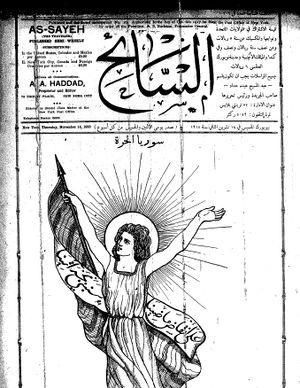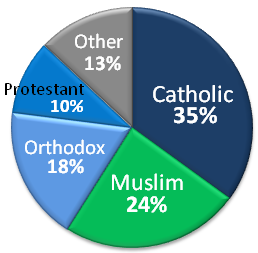الأمريكان العرب
| التعداد الإجمالي | |
|---|---|
| (1,549,725 0.5% من سكان الولايات المتحدة (2008)[1] or 3,500,000 1.14% من سكان الولايات المتحدة (2009)[2]) | |
| المناطق ذات التواجد المعتبر | |
| كاليفورنيا, فلوريدا, إلينوي, مساتشوستس, مشيگن, نيو جرزي, نيويورك, اوهايو, اوكلاهوما, پنسلڤانيا, تكساس, ڤيرجينيا وفي مناطق أخرى. | |
| اللغات | |
| إنگيزية أمريكية, العربية, السريانية, الكردية, الفرنسية ولغات أخرى. |
العرب الأمريكان هم العرب المقيمين في الولايات المتحدة الأمريكية، ومنهم 80% حاصلين على الجنسية الأمريكية. ينحدر العرب الامريكان من غالبا البلاد العربية والتي تتكون من 22 دولة بدءا من عمان في أقصى الشرق الجنوبي للعالم العربي حتى موريتانيا في أقصى غرب افريقيا.
According to the Arab American Institute (AAI), countries of origin for Arab Americans include Algeria, Bahrain, Chad, Comoros, Djibouti, Egypt, Iraq, Jordan, Kuwait, Lebanon, Libya, Mauritania, Morocco, Oman, Qatar, Israel, Palestine, Saudi Arabia, Sudan, Syria, Somalia, Tunisia, United Arab Emirates, and Yemen.[3]
According to the 2010 U.S. Census, there are 1,698,570 Arab Americans in the United States.[4] 290,893 persons defined themselves as simply Arab, and a further 224,241 as Other Arab. Other groups on the 2010 Census are listed by nation of origin, and some may or may not be Arabs, or regard themselves as Arabs. The largest subgroup is by far the Lebanese Americans, with 501,907,[5] followed by; Egyptian Americans with 190,078, Syrian Americans with 187,331,[6] Iraqi Americans with 105,981, Moroccan Americans with 101,211, Palestinian Americans with 85,186, and Jordanian Americans with 61,664. Approximately 1/4 of all Arab Americans claimed two ancestries.
A number of native non-Arab ethnic groups in Western Asia and Northern Africa that may have lived in Arab countries and are now resident in the United States are not always classified as Arabs but some may claim a dual Arab-non-Arab identity; they include Assyrians, Arameans, Jews (in particular Mizrahi Jews, some Sephardi Jews), Copts, Kurds, Iraqi Turkmens, Mandeans, Circassians, Shabaki, Armenians, Yazidis, Balochs, Kawliya/Romani, Syrian Turkmens, Somalis, Djiboutians, Berbers (especially Arab-Berbers), and Nubians.
. . . . . . . . . . . . . . . . . . . . . . . . . . . . . . . . . . . . . . . . . . . . . . . . . . . . . . . . . . . . . . . . . . . . . . . . . . . . . . . . . . . . . . . . . . . . . . . . . . . . . . . . . . . . . . . . . . . . . . . . . . . . . . . . . . . . . . . . . . . . . . . . . . . . . . . . . . . . . . . . . . . . . . . .
التعداد
The majority of Arab Americans, around 62%, originate from the region of the Levant, which includes Syria, Lebanon, Palestine and Jordan, although overwhelmingly from Lebanon. The remainder are made up of those from Egypt, Morocco, Algeria, Iraq, Libya, the GCC and other Arab nations.
There are nearly 3.5 million Arab Americans in the United States according to The Arab American Institute. Arab-Americans live in all 50 states and in Washington, D.C., and 94% reside in the metropolitan areas of major cities. According to the 2010 U.S. Census, the city with the largest percentage of Arab Americans is Dearborn, Michigan, a southwestern suburb of Detroit, at nearly 40%. The Detroit metropolitan area is home to the largest concentration of Arab Americans (403,445), followed by the New York City Combined Statistical Area (371,233), Los Angeles (308,295), San Francisco Bay Area (250,000), Chicago (176,208), and the Washington D.C area. (168,208).[7](Note: This information is reportedly based upon survey findings but is contradicted by information posted on the Arab American Institute website itself, which states that California as a whole only has 272,485, and Michigan as a whole only 191,607. The 2010 American Community Survey information, from the American Factfinder website, gives a figure of about 168,000 for Michigan.)
Sorting by American states, according to the 2000 U.S. Census, 48% of the Arab-American population, 576,000, reside in California, Michigan, New York, Florida, and New Jersey, respectively; these 5 states collectively have 31% of the net U.S. population. Five other states - Illinois, Texas, Ohio, Massachusetts, and Pennsylvania - report Arab-American populations of more than 40,000 each. Also, the counties which contained the greatest proportions of Arab-Americans were in California, Michigan, New York, Florida, New Jersey, Ohio, Pennsylvania, and Virginia.
The cities with 100,000 or more in population with the highest percentages of Arabs are Sterling Heights, Michigan 3.69%; Jersey City, New Jersey 2.81%; Warren, Michigan 2.51%; Allentown, Pennsylvania 2.45%; Burbank, California 2.39% and nearby Glendale, California 2.07%; Livonia, Michigan 1.94%; Arlington, Virginia 1.77%; Paterson, New Jersey 1.77%; and Daly City, California 1.69%.[8] Bayonne, New Jersey, a city of 63,000, reported an Arab-American population of 5.0% in the 2010 US Census.[9]
التاريخ
السكان
62% من العرب الأمريكان أصلهم من دول الهلال الخصيب (فلسطين، لبنان، سوريا، والاردن. أما العرب من أصل مصري فيكونون 11 % من العرب الأمريكان. العرب من العراق، دول المغرب العربي والدول العربية الأخرى يكونون النسبة الباقية من العرب الأمريكان وهي 27%. أكبر التجمعات العربية في أمريكا موجودة في ولايات كاليفورنيا، ميتشيغان، ونيويورك
-| الأصل | 2000 | % من السكان |
|---|---|---|
| 37,714 | 0.01% | |
| 137,462 | 0.03% | |
| 440,279 | 0.2% | |
| 142,832 | 0.1% | |
| 72,112 | 0.02% | |
| 142,897 | 0.1% | |
| 15,000 | 0.005% | |
| عرب آخرون | 424,807 | 0.2% |
| الاجمالي | 1,275,641 | 0.42% |
خلفية دينية
While the majority of the population of the Arab World is composed of people of the Muslim faith, most Arab Americans, in contrast, are Christian[11].
يكون العرب المسيحيين ما نسبته 77% بينما يكون المسلمون 23% من العرب الأمريكان. يصنف العرب الأمريكان على انهم عرق أبيض من الحكومة ودائرة الاحصاء الأمريكية.
تبعا للمعهد العربي الأمريكي، تنقسم الانتماءات الدينية للعرب الأمريكان كالتالي:
- 63% مسيحيون
- 35% كاثوليك (رومان كاثوليك، كاثوليك شرقيون، موارنة)
- 18% أرثوكس (أرثوذكسية شرقية)
- 10% پرتوستانت
- 24% مسلمون
- 13% آخرون; يهود، بلا ديانة [12]
الوضع العرقي

السياسة
المهرجانات/ملكات الجمال
ملكة جمال الولايات المتحدة العربية
- Holy160.jpg
ملكة جمال الولايات المتحدة العربية
مدينة نيويورك
سياتل
فيونكس
. . . . . . . . . . . . . . . . . . . . . . . . . . . . . . . . . . . . . . . . . . . . . . . . . . . . . . . . . . . . . . . . . . . . . . . . . . . . . . . . . . . . . . . . . . . . . . . . . . . . . . . . . . . . . . . . . . . . . . . . . . . . . . . . . . . . . . . . . . . . . . . . . . . . . . . . . . . . . . . . . . . . . . . .
مشاهير الأمريكان من أصل عربي
الترفيه:
- DJ Khaled, (Palestinian) rapper, music producer.
- Frank Zappa, (Musician).
- [[Nazareth][2]] (Palestinian) stand-up comedian Appeard on NBC Nightly News with Tom Brokaw, Comedy Central, ABC Family, and FOX.
- Paul Anka, (Syrian/Lebanese) singer/songwriter.
- Vince Vaughn, Actor
- Ronnie Khalil (Egyptian parents) stand-up comedian, taped comedy specials for Showtime Arabia, sketches on Conan O'Brien.
- Salma Hayek, (Lebanese father), Hollywood actress.
- Shakira Mebarak, (Lebanese Father) Singer-Songwriter
- Valerie Domínguez Tarud, (Lebanese descent) Previous Miss Columbia
- Shannon Elizabeth, (Syrian father), Hollywood actress (American Pie).
- Sammy Hagar, (Lebanese), rock musician. Former lead singer of Van Halen.
- Tony Shalhoub, (Lebanese) an executive producer and actor of Monk.
- Fredwreck, (Palestinian), hip hop producer.
- هدى قطب، مذيعة أخبار تلفزيونية (مصرية) في برنامج ديتلاين إن بي سي وتوداي شو.
- Jamie Farr, (Lebanese) Hollywood actor especially famous for his role as Klinger (also Lebanese) in the TV series "M*A*S*H".
- George Nader, (Lebanese) 1950's Hollywood Actor.
- Danny Thomas, (Lebanese) actor and his daughter Marlo Thomas, actress.
- Casey Kasem, (Lebanese) radio personality and voice actor.
- Anissa Jones, {Lebanese maternal grandparents} actress Family Affair
- Vic Tayback, (Syrian), Actor
- Michael Ansara (Syrian), Actor
- Suzy Kassem, (Egyptian) filmmaker, writer, and poet.
- Fawaz Gerges, ABC analyst, regular guest on Oprah's Anti-war series.
- Chris Kattan, (Iraqi Jewish father), comedian and actor, best known for his work on Saturday Night Live.
- Kathy Najimy (Lebanese) actress in many American films that include Sister Act.
- Heather Raffo, (Iraqi father) playwright and actress.
- Wafah Dufour, (Saudi Arabian Father) supermodel and singer
- Lorraine Ali, (Iraqi) reporter, editor, culture writer, and music critic for Newsweek.
- Wentworth Miller, (Part Syrian/Lebanese) actor.
- Sanaa Hamri, (Moroccan) music video and movie director; her films include the Sisterhood of the Traveling Pants 2.
- George Noory (Lebanese) radio host, host of Coast To Coast AM with George Noory.
- Remy Munasifi (Iraqi/Lebanese) Youtube sensation.
- Hala Gorani (Syrian) CNN International news correspondent.
- Yousef Abu-Taleb (Jordanian) Actor Lonelygirl15, Film Producer
الرياضة:
- Justin Abdelkader, an American ice hockey forward playing for the Detroit Red Wings of the National Hockey League (NHL).
- Joe Robbie, sports team owner of the NFL Miami Dolphins.
- John Jaha, sports athlete, of the MLB Milwaukee Brewers.
- Doug Flutie, (Lebanese father) NFL Player of the Buffalo Bills and San Diego Chargers.
- Khalid Khannouchi, (Moroccan) Marathon world record holder.
- Nader Abdallah, (Palestinian) NFL Player of the Baltimore Ravens.
- Omar Sheika, (Palestinian) Professional Boxer, 4 time world title challenger.
- Ahmed Kaddour, (Lebanese) Professional Boxer, from NBC show The Contender.
كتاب ومفكرون :
- إدوارد سعيد, (فلسطيني) مفكر وناشط فلسطيني.
- هلن توماس, (لبناني) reporter, columnist and White House correspondent.
- Ismail al-Faruqi, (Palestinian) philosopher and authority on Islam and comparative religion.
- Susie Gharib, co-anchor of the Nightly Business Report, 100 most influential business journalists.
- Hala Gorani, (Syrian) Journalist and anchor of CNN's International Desk.
شخصيات عام/سياسيون:
- Victoria Reggie Kennedy, (Lebanese) Attorney and widow of late Senator Ted Kennedy.
- Selwa Roosevelt, (Lebanese) former Chief of Protocol of the United States and wife of the late Archibald Bulloch Roosevelt, Jr., grandson of President Theodore Roosevelt.
- Mitch Daniels, (Syrian) Governor of Indiana.
- John E. Sununu, (Lebanese/Palestinian) Senator from New Hampshire.
- Spencer Abraham, (Lebanese) Senator from Michigan and Secretary of Energy under Bush.
- Ralph Nader, (Lebanese) consumer advocate, politician, first Arab American to run for President of the United States.
- John H. Sununu, (Lebanese/Palestinian) Governor of New Hampshire and White House Chief of Staff under George H. W. Bush.
- George J. Mitchell, (Lebanese) United States of America special envoy to the Middle East under the Obama administration, .U.S. Senator from Maine, Senate Majority Leader.
- John Abizaid, (Lebanese), retired General.
- George Joulwan, (Lebanese), retired General, former NATO commander-in-chief.
- Zainab Salbi, (Iraqi), co-founder and president of Women for Women International.
- Rosemary Barkett, (Syrian), first woman Supreme Court Justice and Chief Justice for the state of Florida.
- James Zogby, (Lebanese) founder and president of the Arab American Institute.
رجال أعمال:
- Steve Jobs, co-founder of Apple Inc. (Syrian father Abdulfattah Jandali).
- Kaysar Ridha, (Iraqi) businessman and contestant on reality series Big Brother.
- John Zogby, (Lebanese) founder and current President/CEO of Zogby International.
- Najeeb Halaby, (Syrian) father of Queen Noor of Jordan Lisa Elhalabi, Administrator of the Federal Aviation Administration. CEO, and chairman of Pan Am.
- Manuel Moroun, Owner of CenTra, Inc., the holding company which controls the Ambassador Bridge and Michigan Central Depot.
- Jacques Nasser, (Lebanese) Former president and CEO of Ford Motor Company.
- John J. Mack, (Lebanese) Chairman of the Board and CEO of Morgan Stanley.
علماء:
- Charles Elachi, (Lebanese) director of the Jet Propulsion Laboratory.
- Elias Zerhouni (Algerian) current director of the National Institutes of Health.
- أحمد زويل (مصري) فائز بجائزة نوبل في الكيمياء عام 1999.
- فاروق الباز عالم مصري أمريكي يعمل في وكالة ناسا للمساعدة في تخطيطات الاستكشافات العلمية على سطح القمر.
انظر أيضا
- American-Arab Anti-Discrimination Committee
- المعهد العربي الأمريكي
- اللوبي العربي في الولايات المتحدة
- شتات عربي
- الشتات السياسي في الولايات المتحدة
- Hyphenated American
- الشتات العراقي
- لاجئون عراقيون
- مسلمون غربيون
المصادر
- ^ US Census 2008 Community Survey
- ^ http://www.aaiusa.org/about/17/our-history المعهد العربي الأمريكي (AAI)
- ^ "Texas" (PDF). Arab American Institute. 2003. Archived from the original (PDF) on 7 February 2012. Retrieved 26 November 2012.
- ^ Data Access and Dissemination Systems (DADS). "American FactFinder - Results". Archived from the original on 18 January 2015. Retrieved 18 March 2015.
- ^ "B04003. Total Ancestry Reported". United States Census Bureau. 2013 American Community Survey 1-Year Estimates. Archived from the original on 12 February 2020. Retrieved 17 July 2016.
- ^ "SELECTED POPULATION PROFILE IN THE UNITED STATES 2016 American Community Survey 1-Year Estimates". American FactFinder. U.S Census Bureau. Archived from the original on 14 February 2020. Retrieved 11 November 2017.
- ^ "Arab American Population Highlights" (PDF). Arab American Institute Foundation. Washington, DC. Archived from the original (PDF) on 23 July 2011. Retrieved 7 July 2011.
- ^ de la Cruz, G. Patricia; Angela Brittingham (December 2003). "The Arab Population: 2000" (PDF). U.S. Census Bureau. Retrieved 17 October 2016.
- ^ "U.S. Census website". US Bureau of Statistics. Retrieved 18 March 2015.
- ^ Brittingham, Angela. Ancestry 2000:Census Brief. 2004. October 30, 2006. [1]
- ^ The Arab American Institute
- ^ Presentation at Al
وصلات خارجية
- موقع المعهد العربي الأمريكي
- التركيبة الديموغرافية للعرب الأمريكان (انجليزي)
- Us4Arabs.com - Arab American Community Website
- Arab American List - Classified Ads and Jobs
- 2000 U.S. Census Report on the Arab-American population
- Learn more at the Arab American Museum located in Dearborn, Michigan.
- 100 Questions and Answers about Arab Americans
- A full definition of Arab Americans
- Arab American Demographics
- A collection of readings and A/V materials on Arab Americans
- Comprehensive demographics of Arab Americans
- ArabAmerican.Net
- "What's Happening TV Show" Arab Americans in the News
- "Arabic social network and music video web site"
- Arab American Outreach
كتب
- The Arab Americans (The New Americans) High-school level look at Arab Americans
وصلات مهرجانات
- Arab American Festival
- New York Arab American Comedy Festival
- Seattle ArabFest
- Concert of Colors: Metro Detroit's Diversity Festival (ACCESS/AANM)
- Dearborn Arab International Festival
منظمات العرب الأمريكان
- Arab Center of Washington
- Arab American Association
- List of Arab American Organizations
- American-Arab Anti-Discrimination Committee
- Arab American Institute
- / Aramica Newspaper: The Leading Arab American Newspaper on the East Coast
- Arab Artists Resources & Training
- Arab American National Museum
- Association of Patriotic Arab Americans in Military
- The Arab American Council Of Trade















